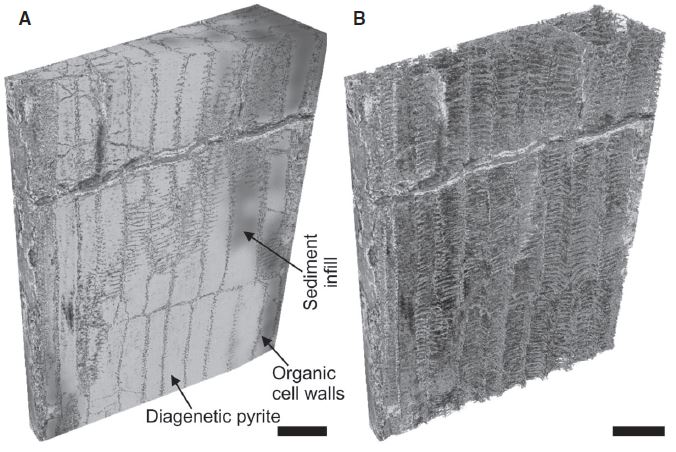Analyzing the world’s oldest woody plant fossil
Mapping the evolution of life requires a detailed understanding of the fossil record, and scientists used the CLS to look at the cell structure and chemistry of the earliest known woody plant.
By Colleen MacPherson(Left) photograph of Armoricaphyton chateaupannense preserved in 2D as carbonaceous thin films. (Right) SEM image of a transverse section of an axis of a specimen of A. chateaupannense preserved in 3D showing the radially aligned tracheids.
Scientists investigate the early evolution of tissue systems in plants.
Mapping the evolution of life on Earth requires a detailed understanding of the fossil record, and scientists are using synchrotron-based technologies to look back—way, way back—at the cell structure and chemistry of the earliest known woody plant.

Dr. Christine Strullu-Derrien and colleagues used the Canadian Light Source’s SM[1] beamline at the University of Saskatchewan to study Armoricaphyton chateaupannense, an extinct woody plant that is about 400 million years old. Their research focused on lignin, an organic compound in the plant tracheids, elongated cells that help transport water and mineral salts. Lignin makes the cells walls rigid and less water permeable, thereby improving the conductivity of their vascular system.
Strullu-Derrien, a scientific associate at the Natural History Museum in London, England and the Natural History Museum in Paris, France, had described A. chateaupannense some years ago and returned to it for this project.
“Studies have been done previously on Devonian plants but they were not woody,” she said. “A. chateaupannense is the earliest known woody plant and it’s preserved in both 2D form as flat carbonaceous films and 3D organo-mineral structures. This allows for comparison to be done between the two types of preservation,” she said.
Although the fossils used in the study were collected in the Armorican Massif, a geologically significant region of hills and flatlands in western France, Strullu-Derrien said early Devonian woody plants have also been found in New Brunswick and the Gaspé area in Québec, “although these are 10 million years younger than the French one.”
One of the challenges in this kind of study is that the fossilization process modifies soft plant tissue, which alters or obscures its original biochemical structure and makes it difficult to precisely reconstruct the original chemistry. This study, however, aided by advanced visualization technologies, identified lignified cells in the fossils, suggesting the plant contained decay-resistant lignin compounds.

“Analyses show that both the 2D and 3D fossils have the same chemical composition, which is different than modern lignin, but the chemical signal of lignin is not completely lost in the fossilization process,” she said. Although the type of preservation of the plant fossils is not unique, “the combination of synchrotron methods used to study the structure and the chemistry of the wood at this level of detail is novel.”
The results of the research are in a paper entitled “On the Structure and Chemistry of Fossils of the Earliest Woody Plant” published by Palaeontology.
Given how ubiquitous and important wood is as a structural component of modern plants, Strullu-Derrien’s investigation advances the knowledge around when and how wood first evolved. Yet, questions remain: “Wood first appears in small plants but did it have a different function than it does today in trees, for example?” posed Strullu-Derrien.
To find an answer, she will apply the same techniques used in this study on plants of other geological ages “to follow the evolution of their structure and to be able to find when, or in what condition of preservation, the remaining organic matter has kept a chemical signal of lignin.”
“Our study illustrates the capabilities of synchrotrons to investigate the early evolution of tissue systems in plants. It’s crucial to have access to these techniques to reach the level of resolution needed for getting chemical signals such as lignin. This represents a developing and promising area for the study of fossils that will complement the morpho-anatomical data and help to interpret the structures,” she said.
[1] Soft X-ray Spectromicroscopy (SM).
Strullu-Derrien, Christine, Sylvain Bernard, Alan RT Spencer, Laurent Remusat, Paul Kenrick, and Delphine Derrien. "On the structure and chemistry of fossils of the earliest woody plant." Palaeontology (2019). DOI: 10.1111/pala.12440.
For more information, contact:
Victoria Schramm
Communications Coordinator
Canadian Light Source
306-657-3516
victoria.schramm@lightsource.ca
